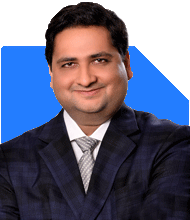How Can I Accumulate 10 Crore by Age 50 with a 3.5 Lakh Monthly Salary?
Ramalingam Kalirajan |10881 Answers |Ask -Follow
Mutual Funds, Financial Planning Expert - Answered on Nov 25, 2024
He has an MBA in finance from the University of Madras and is a certified financial planner.
He is the director and chief financial planner at Holistic Investment, a Chennai-based firm that offers financial planning and wealth management advice.... more

Hi my name is Mani and aged 36 i am drawing a monthly salary of 3.5lakhs. Below are my investments. I want to achieve around 10Cr by 50. Current MF potfolio:50L Shares/ETF: 10L PF: 39L US ESOP: 1.2 Crore Monthly SIP: 1.65Lkhs 2 houses: 95L & 60L I can invest upto 2.5-3lakhs montly. Closed all my loans.
Assessment of Current Investments
Mutual Fund Portfolio: Rs 50 Lakh
This portfolio forms a significant part of your wealth.
Equity mutual funds can offer long-term growth.
Regular reviews and diversification will enhance returns.
Shares and ETFs: Rs 10 Lakh
Direct equity and ETFs require active monitoring.
ETFs have limitations, like tracking errors and passive management.
Disadvantages of ETFs:
Lack of flexibility to outperform benchmarks.
Returns are limited to market indices, missing active management benefits.
Provident Fund: Rs 39 Lakh
PF is a safe, tax-efficient retirement tool.
Growth is limited compared to equity investments.
US ESOP: Rs 1.2 Crore
ESOPs provide substantial value, but currency and company risks exist.
Diversification is essential to reduce concentrated risk.
Monthly SIPs: Rs 1.65 Lakh
A high monthly SIP reflects your commitment to wealth creation.
Fund selection and risk balance will determine growth.
Real Estate: Rs 95 Lakh and Rs 60 Lakh
While real estate offers stability, liquidity issues can be a challenge.
Rental income should align with market returns to remain beneficial.
Strategy to Achieve Rs 10 Crore by 50
1. Optimise Mutual Fund Investments
Increase allocation to actively managed equity funds.
Diversify into large-cap, mid-cap, and hybrid funds for balanced growth.
Review the portfolio with a Certified Financial Planner every year.
2. Enhance Monthly SIP Contributions
Increase SIPs to Rs 2.5-3 lakh, matching your investment capacity.
Prioritise equity mutual funds for better compounding over 14 years.
Allocate a small portion to debt funds for stability.
3. Reevaluate Direct Equity and ETFs
Limit ETFs due to their passive nature and tracking errors.
Focus on direct equity only if you have time for active monitoring.
Otherwise, shift to professionally managed equity funds.
4. Diversify US ESOP Holdings
Reduce dependency on your company’s ESOPs.
Gradually liquidate and reinvest in Indian equity and international mutual funds.
Diversification will safeguard against market volatility and currency risks.
5. Leverage Provident Fund Efficiently
PF will act as a stable component of your retirement corpus.
Do not withdraw unless essential.
6. Address Real Estate Investments
Analyse the rental yield and growth potential of your properties.
If returns are below expectations, consider selling one property.
Reinvest proceeds in mutual funds for higher returns and liquidity.
Tax Efficiency and New Rules
Equity Mutual Funds
Long-term capital gains (LTCG) above Rs 1.25 lakh are taxed at 12.5%.
Short-term capital gains (STCG) are taxed at 20%.
Plan withdrawals strategically to reduce tax liability.
Debt Funds
Gains are taxed as per your income slab.
Use systematic withdrawal plans for efficient taxation.
ESOPs and Real Estate
ESOPs will attract capital gains tax upon sale.
Real estate gains are taxed under capital gains rules.
Invest gains from property sales into mutual funds to save on taxes.
Additional Recommendations
1. Adequate Life and Health Insurance
Ensure you have term insurance covering at least 10 times your annual income.
Maintain comprehensive health insurance for your family.
2. Emergency Fund
Keep six months’ expenses in a liquid fund or savings account.
This ensures liquidity during unforeseen circumstances.
3. Monitor and Rebalance Portfolio
Regularly review asset allocation with a Certified Financial Planner.
Adjust based on market conditions and financial milestones.
Final Insights
You are on the right track with your disciplined investing approach. To ensure you reach Rs 10 crore by 50, optimise your investments, enhance tax efficiency, and diversify risks. Focus on actively managed funds, reduce dependence on real estate, and leverage your high savings potential. Regular monitoring and strategic decisions will make your goal achievable.
Best Regards,
K. Ramalingam, MBA, CFP
Chief Financial Planner
www.holisticinvestment.in
https://www.youtube.com/@HolisticInvestment
You may like to see similar questions and answers below
Hardik Parikh | Answer |Ask -Follow
Tax, Mutual Fund Expert - Answered on Apr 11, 2023
Sunil Lala | Answer |Ask -Follow
Financial Planner - Answered on Sep 04, 2023
Dr Dipankar Dutta |1841 Answers |Ask -Follow
Tech Careers and Skill Development Expert - Answered on Dec 14, 2025
Nayagam P P |10854 Answers |Ask -Follow
Career Counsellor - Answered on Dec 14, 2025
Radheshyam Zanwar |6744 Answers |Ask -Follow
MHT-CET, IIT-JEE, NEET-UG Expert - Answered on Dec 14, 2025
Radheshyam Zanwar |6744 Answers |Ask -Follow
MHT-CET, IIT-JEE, NEET-UG Expert - Answered on Dec 14, 2025
Dr Dipankar Dutta |1841 Answers |Ask -Follow
Tech Careers and Skill Development Expert - Answered on Dec 14, 2025
Dr Dipankar Dutta |1841 Answers |Ask -Follow
Tech Careers and Skill Development Expert - Answered on Dec 13, 2025
Dr Dipankar Dutta |1841 Answers |Ask -Follow
Tech Careers and Skill Development Expert - Answered on Dec 13, 2025
Mayank Chandel |2575 Answers |Ask -Follow
IIT-JEE, NEET-UG, SAT, CLAT, CA, CS Exam Expert - Answered on Dec 13, 2025
Radheshyam Zanwar |6744 Answers |Ask -Follow
MHT-CET, IIT-JEE, NEET-UG Expert - Answered on Dec 13, 2025
Mayank Chandel |2575 Answers |Ask -Follow
IIT-JEE, NEET-UG, SAT, CLAT, CA, CS Exam Expert - Answered on Dec 13, 2025






















